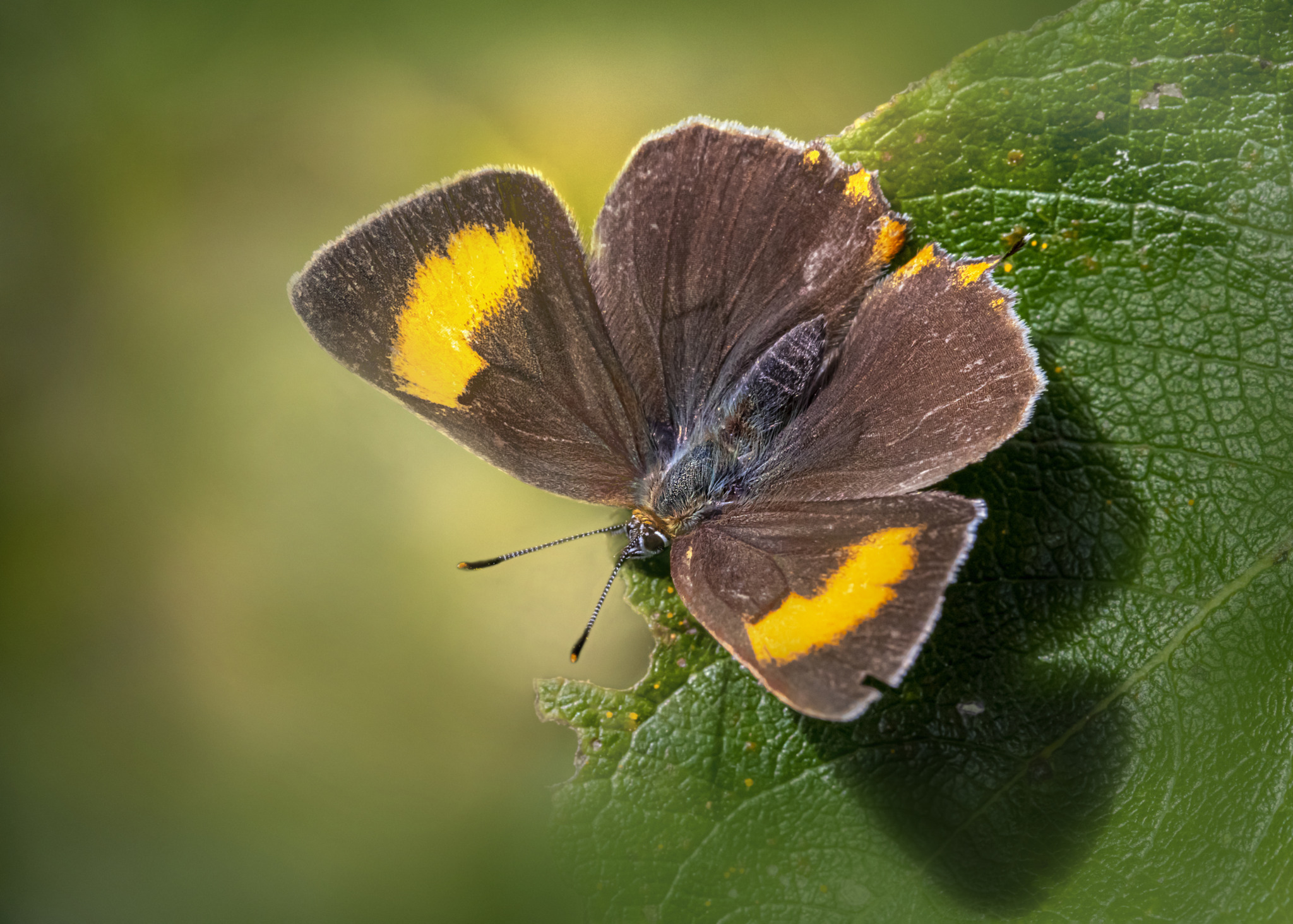Deep Overview: Brown Hairstreak (Thecla betulae)
The Brown Hairstreak (Thecla betulae) is a secretive, late-season butterfly known for its golden-brown wings with striking orange patches. Despite being widespread in Europe and temperate Asia, it is rarely seen due to its habit of spending most of its life high in trees. This species plays a crucial role in hedgerow and woodland ecosystems, relying on blackthorn (Prunus spinosa) as its primary larval host plant.
Taxonomy & Classification
- Kingdom: Animalia
- Phylum: Arthropoda
- Class: Insecta
- Order: Lepidoptera
- Family: Lycaenidae (Blues, Coppers, and Hairstreaks)
- Genus: Thecla
- Species: Thecla betulae
- Common Names:
- Brown Hairstreak
Physical Description
- Wingspan: 34–44 mm (1.3–1.7 in)
- Coloration & Markings:
- Males:
- Dark brown upperwings with a small orange patch near the base
- Females:
- Similar to males but with larger, brighter orange patches
- Underwings (both sexes):
- Golden brown with fine white streaks (“hairstreaks”)
- A thin white line runs diagonally across the hindwings
- Small tails on the hindwings resemble antennae, confusing predators
- Males:
- Key Features:
- Males are smaller and darker than females
- Cryptic coloration makes them difficult to spot when resting
Distribution & Habitat
- Geographic Range:
- Found across Europe, the UK, and temperate Asia
- Populations extend from Spain to Scandinavia and eastward to Siberia
- Preferred Habitat:
- Woodland edges, hedgerows, scrubland, and orchards
- Prefers areas with abundant blackthorn shrubs, used for egg-laying
Behavior & Adaptations
- Elusive & Tree-Dwelling:
- Adults spend most of their time high in trees, feeding on honeydew instead of flowers
- Territorial Males:
- Males establish small territories in treetops, often competing for perching spots
- Short Flight Season:
- Adults emerge from late July to October, with peak activity in August and September
- Camouflage & Mimicry:
- Hindwing tails resemble antennae, confusing predators into attacking the wrong end
Diet & Feeding Habits
- Caterpillars (Larvae):
- Feed on blackthorn leaves (Prunus spinosa), occasionally other Prunus species
- Adult Butterflies:
- Primarily feed on aphid honeydew in treetops, rarely visiting flowers
- Occasionally seen nectaring on bramble, heather, and thistles
Reproduction & Life Cycle
- Breeding Season:
- Late summer to early autumn
- Egg-Laying:
- Females lay eggs singly on blackthorn twigs, often near growth buds
- Caterpillar Stage:
- Green with a slight pinkish hue, resembling leaves
- Extremely well-camouflaged, making it hard to spot
- Pupation & Overwintering:
- Overwinters as an egg, enduring frost and harsh conditions
- Caterpillars emerge in spring when blackthorn leaves appear
- Lifespan:
- Adults live about 3–4 weeks
Predators & Threats
- Natural Predators:
- Birds, parasitic wasps, and predatory insects
- Human-Related Threats:
- Hedgerow removal for agriculture reduces breeding sites
- Overzealous hedge-cutting destroys overwintering eggs
- Pesticide use harms caterpillars and host plants
- Conservation Status:
- Declining in many areas, but still classified as Least Concern (LC)
Ecological Importance
- Pollinator:
- Helps maintain wildflower diversity
- Indicator of Healthy Hedgerows:
- Their presence signifies well-managed, biodiverse habitats
- Part of the Food Chain:
- Caterpillars provide food for birds, wasps, and other predatory insects
Relationship with Humans
- Hedgerows Are Crucial:
- Well-managed hedgerows support populations by providing egg-laying sites
- Difficult to Spot:
- Rarely seen due to tree-top dwelling behavior
- Conservation Efforts:
- Focus on preserving hedgerows and limiting hedge-cutting to winter months
Fun Facts
- Eggs are among the most distinctive of any British butterfly, often found in winter on blackthorn twigs
- Despite its name, it has no direct connection to birch trees (“betulae”)
- Unlike many butterflies, it spends little time feeding on flowers
- The White-letter Hairstreak (Satyrium w-album) is a close relative with a more striking white pattern
Conclusion
The Brown Hairstreak is a secretive and beautiful butterfly, spending much of its life hidden in woodland canopies. Its survival is tied to hedgerows and blackthorn, making it an important indicator species for habitat conservation. Though rarely seen, careful management of rural landscapes can help protect and sustain its populations.
Views: 1313
Subscribe to the newsletter:
